You know what this is. Rules are as such:
I had to play a game for the first time in 2021 for it to be a nominee.
That is all. The games are listed in the order that I played them. Let us commence!
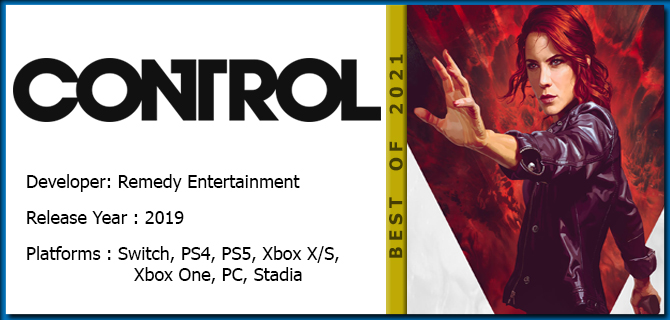
Control is, without a doubt, the best game that I played this year (that was originally released in 2019). It is a 3rd-person shooter that is all about paranormal phenomenon, including psychic powers, alternate dimensions, and invisible, sound-based monsters. Imagine, if you will, a video game that has a plot straight out of The X-Files or Fringe, but your character plays as if she’s a blaster-wielding Jedi. To sum it up, Control is incredibly cool, interesting, and fun. Way to hit the trifeca, Remedy Entertainment!
Control puts you in the shoes of Jesse, a vagabond in search of her missing brother, who was abducted as a child by mysterious agents after a large-scale paranormal event made all the adults in their town disappear. Jesse strides into the headquarters of the Federal Bureau of Control (called the Oldest House), unaware that the building is in the middle of a lockdown due to an invasion of inter-dimensional beings known as the Hiss. Before long, she unexpectedly becomes the Director of the FBC and is charged with the task of expunging the Hiss from the Oldest House before they can escape and wreak havoc on the rest of our dimension.
When I first started playing Control, I was thrown off a little by Jesse’s very swift movement speed, but once I got that under control (ha!), I became completely hooked and quite literally didn’t play anything else until I’d finished the game. And by finished, I mean finished. Not only did I score all of the trophies in the base game, but I also played both DLC campaigns to 100%. Running around and felling foes with Jesse’s ever-expanding arsenal of both firearms and superpowers is an absolute blast (haa!!), but it really takes off once you gain the power to levitate (haaa!!!). The extra layer of mobility isn’t something you see in a ton of games, and Remedy absolutely nailed the controls, as it feels wonderful and natural just to move Jesse around the game world. I’d like to also note that the hundreds of collectible text, audio, and video files that you find scattered throughout the Oldest House remain interesting from start to finish, and seeking them all out is reason enough to play the game.
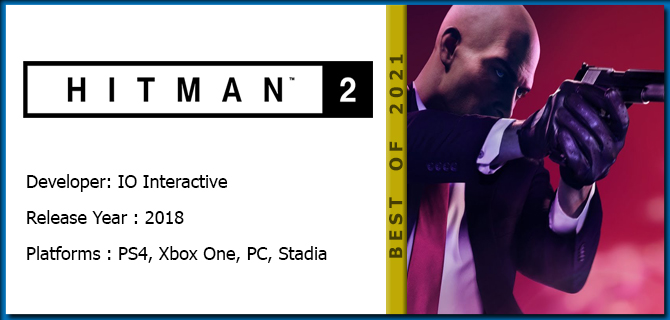
Hitman was never a franchise that ever really sparked interest in me over the years. A multiple points throughout my life, various friends have tried to extol its virtues to me, but it never stuck for whatever reason. I don’t know if it’s because the Hitman reboot from 2016 is a significantly better game than its predecessors, or if it’s because I finally sat down with it and gave it the time it deserved, but now I’m in deep with not only Hitman, but also its 2018 sequel/expansion. (I’ll dive into Hitman 3 when I’m done with these two.)
The second paragraph here is reserved to talk about the plot of each game on this list, but… honestly, I don’t really know what the plot is in Hitman or Hitman 2. The tutorial missions are based around Agent 47’s induction into the ICA, and then I think time skips forward to somewhere farther along in his career of being the best assassin ever. I also believe that despite this appearing to be a reboot, it does take place within the same continuity as all the other Hitman games. But I don’t know! honestly, the plot is far and away the least interesting part of these games!
At a glance, Hitman appears to be a fairly cookie-cutter, stealth-based third-person shooter. Lo and behold, it’s secretly a puzzle game wherein sometimes you will shoot people. Maybe I always bounced off the series before because I didn’t realize that? Anyway, in any given mission, your job as Agent 47 is to assassinate one or two or five people, and how you go about it is totally up to you. You can steal costumes to sneakily work your way close to your target and then drown them in a toilet while they’re pooping. Or you can use one of many environmental objects to orchestrate an “accident” that crushes them into a fine paste. Or maybe you just want to go in guns blazing and then make a hasty retreat. That probably won’t work, but you can try! And while each game only has six or seven core missions, each one of those missions has like a billion bonus objectives that range from simple to mind-boggling, and will keep completionists playing for months. Hence why I won’t be playing Hitman 3 any time soon.
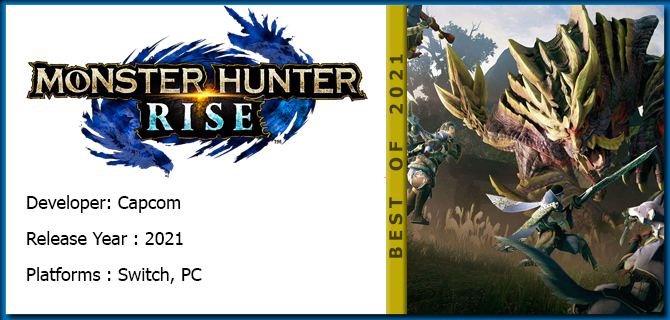
The fact of the matter here, is that I’m going to play pretty much every new Monster Hunter game released. Well, except for spin-offs, and mobile games, and games not released outside of Japan, and games that are released on consoles that I don’t have. But most of those things didn’t apply in 2021! So I played exactly one of the two Monster Hunter games released last year, and I’m pretty darn happy I picked this one.
The plot of Monster Hunter Rise is… barely there. Like with most MH games, there’s some sort of weird phenomenon endangering your village. As a hunter, it’s your job to go out and find the monster responsible, and slay it. In this particular edition, the phenomenon in question is some kind of malevolent force that makes all the local monsters go nuts and rampage the village. It seems at first like the samurai-lookin’ Magnamalo is at the core of the problem, but might there be more to it????
Monster Hunter Rise is, at a high level, not appreciably different than any of the Monster Hunters before it. Or at least, it’s not appreciably different than Monster Hunter World. Rise takes most of the big changes from than game, and adds a few extra refinements here and there to create what must scientifically be the best Monster Hunter to date. However! There’s one major change that totally upends the traditional gameplay: the wirebug. An inversion of MHWorld’s slinger, the wirebug is a new piece of equipment that allows you to shoot out a grappling hook and immediately zoom to your destination. The coolest part is that you don’t need an actual target to hook to, so in addition to using it to climb walls, you can also chain grapples to fly through the air and cover massive amounts of horizontal distance. The wirebug also has combat applications, allowing you to dash out of harm’s way, pull off new special moves, or tie up a monster to hold it still while you smack it silly. Needless to say, the wirebug gives you a boatload of new movement options, and makes you feel like a badass ninja. It doesn’t seem like an especially big change to the formula at first, but once you learn to use the wirebug to it’s full extent, you’ll be left wondering how you ever lived without it.
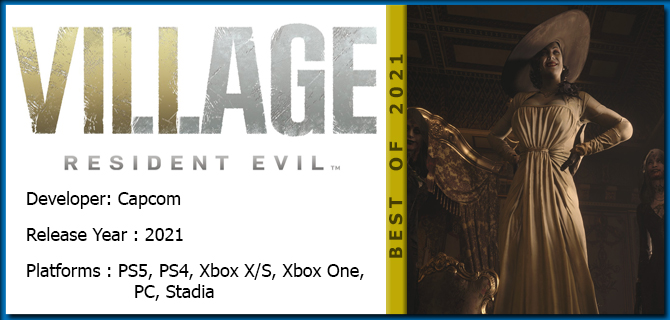
I don’t think that I ever formally announced it on the blog, but I got a Playstation 5 this year. It was actually a slightly delayed Xmas gift from my family, who really came through it a big way. See, at the time, Capcom was saying that Resident Evil Village was only going to be released on the newest generation of consoles, and I really didn’t want to have to wait for it. Of course, then they backpedaled and put Village on the PS4 and whatnot anyway, but I’m glad I ended up playing the PS5 version. It has no loading screens at all!
Village takes place some length of time after the events of Resident Evil 7, with Ethan and Mia having settled down in the quiet wilderness of Nowhere, Europe. They now have a chubby widdle bab, though the lingering stress of the whole Eveline fiasco seems to have turned Mia into a major bitch. Fortunately for us, the players, she gets a few bullets in the head within five minutes, courtesy of series hero Chris Redfield. Ethan and baby Rose are abducted, but the transport vehicle crashes along the way, and Ethan sets out on the hunt to find his daughter. This lands him square in the middle of a rural village (ohhh!) populated by countless werewolves, a sorority of bug-vampires, and Magneto from X-Men, among other wacky monsters. Baby Rose has fallen into the hands of this group of no-goodniks, and Ethan will need to slaughter each and every one of them if he ever hopes to receive a World’s Best Dad coffee mug as a Father’s Day gift from Rose some years down the line!
For better or for worse, Resident Evil Village strays away from the slow, tense, return to horror that was established in Resident Evil 7. It still has some parts like that! But for the most part, it was developed with a lot of inspiration from Resident Evil 4, and ends up feeling like a first-person version of that game most of the time. Which is perfectly good! I think they struck a great balance between action and horror in this one. The true genius of Village, however, is in its structure. The titular village acts like a hub, and branches off into four directions for each of the game’s themed “levels”. All four of these areas play somewhat differently, which messes with the game’s pace a bit, but I appreciated the variety. And each time you complete one of these levels, you return to the village, and you’re able to access more areas that were previously blocked off in one way or another, which makes it fun and interesting to re-explore the village every time you pass through. All of these factors combine into a really fantastic experience that kept me coming back for multiple playthroughs (four to date), and I look forward to even more in the future.
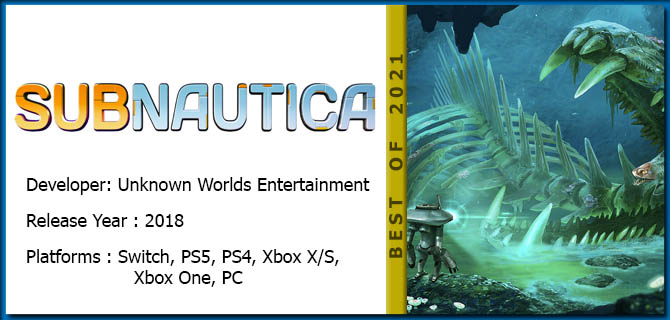
I’d heard of Subnautica in passing before 2021. But there’s a certain truth to the idea that underwater levels are usually the worst, so why would I take interest in a game that is entirely underwater? Well, because at some point this year, I started picking up on the fact that people kept comparing it to Metroid Prime. Oh and also Sony was giving it away for free for a while in the spring. Those are two very good ways to make me notice in your product.
Subnautica sort of has two stories, but I’m only going to tell you about one, because the other is best discovered and unraveled as you play. When the game starts, you’re a crew member on board a spaceship, on a secret rescue mission to an unexplored planet called simply 4546B. But then something blasts the ship right out of the sky, and it goes hurtling into the neverending ocean that makes up the surface of 4546B. You come to in a lifepod, alone but receiving radio transmissions from other lifepods. Your immediate goal is to find another surviving crewmates, with the added long-term objectives of keeping yourself alive and ultimately finding a way off the planet.
Subnautica is a hard game to justify putting on any sort of “best of” list, because it is absolutely one of the most broken “finished products” that I have ever seen. Bugs and glitches abound, and crashes become more and more frequent as you get closer to the ending. All that said, I can’t stop thinking about the week that I spent playing this game and wishing desperately that I could experience it for the first time again. Few games have made exploration and discovery as engaging and exciting as Subnautica. It’s not that different from any other survival game: you collect things and combine them to make tools and shelter and food. But every time I built something new, it felt like a major achievement, and every time I set out to explore a new part of the game world, it felt like I was going on an important expedition. For all of its flaws, I don’t think I’ve felt the raw thrill that I got from Subnautica in any other game on this list. Making major discoveries and narrowly escaping gigantic predators was more satisfying in Subnautica than any other game like it, and a lot of why I enjoyed it so much is due to the unique setting and perfectly-crafted atmosphere that surround the constant dopamine rushes.
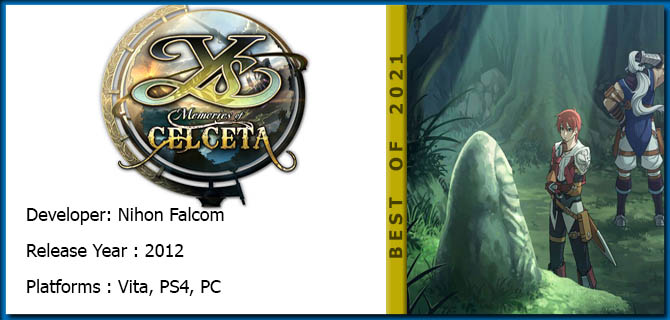
I started this year off with the intent to play through the entire Legend of Zelda series. Never did I imagine that I would also end up playing through most of the Ys series. Not only had I never played an Ys game before, but I barely knew anything about the franchise at all. Then I bought Ys Origin on a whim, fell hard for it, and thus my journey had begun.
Ys: Memories of Celceta is a remake of the fourth game in the series, and also the fourth in the canonical timeline. By this point, Adol Christin has a few adventures under his belt, but somehow winds up stumbling through the town of Casnan with a rough case of amnesia. He remembers nothing but his lust for adventure, which naturally leads him to accept an offer from the local government to explore and chart out the great forest of Celceta. I guess he also figures that since his memories were lost in the forest, the key to restoring them may also be in said forest. But who cares about that? There’s a big ol’ map to fill in!
And indeed, once I was handed the roll of parchment and told to get crackin’, I felt nothing less than pure excitement course through my body. Map-making is one of my absolute favourite things to do in video games, and Memories of Celceta is all about it, so that’s a pretty strong start. Other major selling points for me include: a) it’s an action-RPG b) it’s very fast-paced and c) there’s a records page that tells you how many of the game’s treasure boxes you’ve looted. Oh, and in addition to the raw satisfaction of filling in a map, you actually get rewards for achieving certain map completion percentages. It’s a cartographer’s dream! I suppose it also helps that the characters are all fairly well-rounded and likeable, and the moment-to-moment story beats are interesting, even though the overall plot is a little bit on the JRPG cookie-cutter side. The combat system is also incredibly satisfying, with a strong focus on movement, solid incentives to learn to perfect dodge/guard, and the ability to flip between your party members at the push of a button. It all just flows so smoothly that the amount of fun I was having while playing was more than enough to completely overshadow the game’s few shortcomings (like the weird fast travel system).
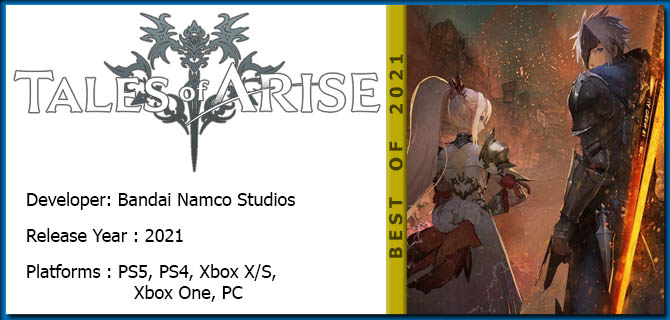
Many, many moons ago, I was a very devoted fan of the Tales series. And then the games started to get… less good. Tales of Legendia was super weird in all the wrong ways, Tales of the Abyss was simply boring, and the sequel to Tales of Symphonia (one of my favourite games of all time) was just terrible all around. I quit the series for a decade, and tried to give it another chance with Tales of Berseria, but that one was a bit of a slog as well. So honestly, I’m not sure exactly what it was that made me want to play Tales of Arise.
Oh, right; it was because the story sounded very interesting! Tales of Arise is the, uh, tale of twin worlds Dahna and Rena. 300 years before the game begins, the people of Rena invade and enslave Dahna with impossibly advanced technology. In the present day, you follow the journey of an unlikely duo, consisting of an amnesiac Dahnan slave and a Renan rebel, who are out to topple the Renan lords in an effort to emancipate the Dahnan people. But why would a young Renan woman of noble status want to overthrow her own people? And why does she sprout evil, purple thorns that inflict severe pain on anyone who touches her? These mysteries and many more are what kept me glued to this game until the very end!
I’ve already written two blog posts on my thoughts about this game, but I suppose I should probably give a short summary here. First off, Tales of Arise’s plot goes places. It isn’t until roughly the halfway point that it truly abandons the rails, but man, I was 100% on board for every twist and turn. Not all twists were equally satisfying, and I would have liked it if a few of the turns had been a little more fleshed out, but I don’t think it would be inaccurate to say that I thoroughly enjoyed the story from start to finish. The combat system is also totally coo-coo bananas, and in the best ways. It is fast and it is furious. If you play your cards right, a lot of enemies can be dispatched before you fully realize what’s happening. Calling in special attacks and finishing moves from your party members (even ones who aren’t in the active party!) feels fresh and is oh-so satisfying. But somehow, at the same time, battle efficiency boils down to playing defensively. Tales of Arise seemed like one of the hardest action-RPGs I’d ever played (on normal!) until I learned that the key to victory is the one-two punch of a perfect dodge followed by a flurry of counterattacks. Once you get that down and learn to exploit your foes’ weaknesses, it gets a lot more manageable. Mastering combat in Tales of Arise makes it fun to fight each and every encounter, and it never got dull over my 80-ish hours of play.
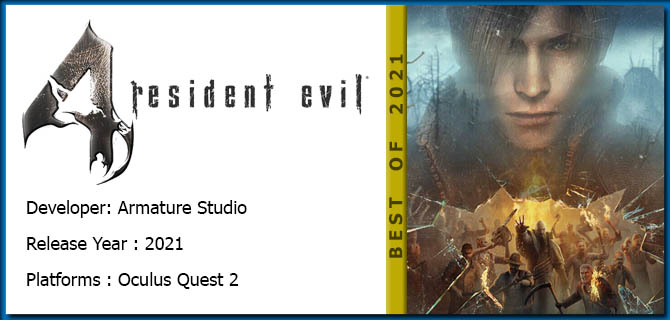
Were you around, back in 2005, when I crowned the very first release of Resident Evil 4 as my Game of the Year? Because that’s a thing that happened. If I had done a GOTY list in 2007, I probably would have given the Wii re-release a top spot, due to how well the new motion controls were implemented and how they truly changed the game. And now, in the far-flung future of 2021, we have a VR version of the game that is so good that I feel compelled to yet again declare it one of the best games of the year.
Let’s be honest, Resident Evil 4 has been released on any machine that is capable to playing a video game at this point. You can probably play it on certain models of toasters. You know what it’s about. Leon S. Kennedy, rookie cop hero of Raccoon City, is out on a European adventure to save the president’s daughter. Attempting to stop a new bio-weapon may or may not be something that he ends up doing along the way.
Rebuilding Resident Evil 4 from the ground up to be a VR game is nothing short of revolutionary. This is, for all intents and purposes, exactly the game that you know and love. Each and every nook, cranny, and monster hidey-hole is here for you to examine from a completely new perspective. And I did just that! So much time in my non-recorded playthoughs has been devoted to simply looking at the environments and being in awe of how amazing it is to actually be in them. It’s exactly the same feeling I got when playing Five Nights at Freddy’s: Help Wanted last year, only amplified by like a thousand since RE4 is easily one of my most-played games ever. Armature Studio also did an incredible job of making the game feel great to play from this new vantage point, having clearly put a ton of love and polish into the control and balance of the moment-to-moment gameplay. There is also a gigantic list of options that help to make the game accessible to basically anyone, regardless of their level experience with or tolerance for VR. Well, except for people that have breasts, since the chest-mounted items can be difficult to grab if you’ve got real-life boobs in the way of where your virtual hands need to be. But my moobs are small enough that they didn’t cause me any issues, and as such, my four playthroughs of the game have nothing but absolute bliss.
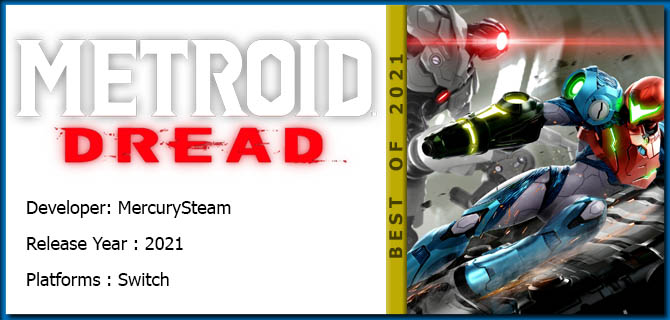
Did you know that Nintendo hasn’t released an entirely new 2D Metroid since 2002? Yeah, it’s been nearly 20 years since the previous (side-scrolling, non-remake) installment in the series, Metroid Fusion. Part of the reason that Metroid Dread was my most anticipated game of 2021 is because of that huge gap in releases. The other part was because holy cow did that reveal trailer ever look cool!
Continuing the story from Fusion, where Samus had put an end to the unbelievably dangerous X parasites, Dread opens with Samus receiving a transmission that informs her that her work was not quite done. The video shows an X floating around on planet ZDR, and since the Galactic Federation’s EMMI robots vanished after being sent in to investigate, Samus has no choice but to fly down to the planet to finish her complete and utter genocide of yet another species. Once there, she gets dunked on by a mysterious Chozo, and so begins her latest adventure to reclaim all her cool murder toys.
The first thing you’ll notice when playing Metroid dread is that Samus is more nimble than ever. She runs very quickly, can free-aim in any direction, and has a sweet new slide move to evade foes and get through tight spaces. Needless to say, it feels better than ever to move Samus around the game world, which is something that’s very important to my personal enjoyment of almost any video game. Dread also lives up to its name by being tough as nails. While running around the map isn’t generally too harrowing in and of itself, there are two factors that really amp up the tension. Firstly, the boss fights are harder than ever. While the Metroid series has never shied away from being challenging, some of the bosses in Dread were shockingly difficult; gone are the days of spamming missiles until you win. The final boss in particular probably took me a good hour of practice to finally defeat (and is the one that I would argue is too hard). Secondly, the EMMI robots that I mentioned briefly before act as sentinels in specific areas, and they’ll ceaselessly chase Samus if they happen to spot her. If you happen to get caught by one, you have a tiny window to hit a QTE to escape, or else you’re insta-killed. Fortunately, neither of these factors ever got frustrating, despite the fact that they sound like they should be. The EMMI zones added a much-needed thrill to exploration of each area, and the boss fights were all about learning the foes’ patterns and finding openings to counterattack (very much like in the brutally difficult, Metroid-inspired Hollow Knight). Neither ever felt unfair or tedious, but rather injected huge amounts of excitement into the game and made me feel like an absolute boss when I overcame them.
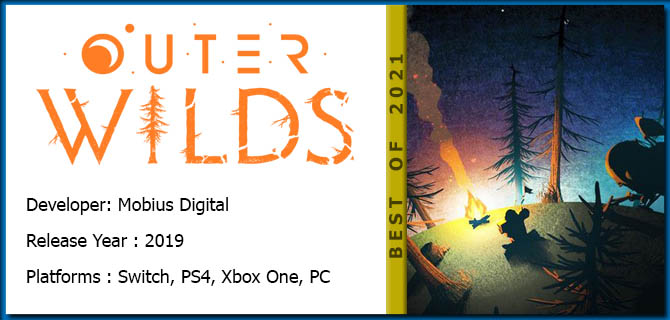
Around the time when Outer Wilds was released in 2019, I watched a livestream of roughly an hour’s worth of gameplay, and didn’t feel overley interested in learning much more about it. Then in November of 2021, I read (most of) a blog post about why the game’s DLC should have been a sequel instead. After reading that post, I knew more confidently than I’ve ever known anything before that I absolutely had to play Outer Wilds.
Outer Wilds is a tricky game to describe, at least if you want to tell people about the plot without giving anything away. You play as a spacecraft pilot, about to go on your very first solo flight. You go on a short tour of the village, talking to all your fellow citizens, get the launch codes from the space program director, and then hop in your spaceship and blast off. From there, where you want to go and what you’d like to explore is all up to you. There’s an actual (very good) story to unearth, yes, but you’re going to have to figure it all out on your own.
This is a video game that is entirely about exploration and is completely self-directed. Sure, your ship’s computer can point you in the direction of something interesting, but only if you’ve already discovered something worth following up on. And there are lots of those! The most wonderful thing about Outer Wilds is that every single discovery you make rewards you with information. There are zero items to collect or keys to find. You start with every piece of equipment you’ll ever need, and half of your progress is made by learning to use them in different ways. The other half is learning how all the mechanics within the solar system work, whether that means abandoned alien technology or quantum physics or one of the other dozens of awesome things out there for you to discover. And then you mash it all together to figure out the final objective and how to go about accomplishing it. I don’t think it’s a stretch to say that Outer Wilds has some of the most satisfying puzzle solving of any video game I’ve ever played, and that’s largely due to the fact that all the puzzles are solved by being observant and applying knowledge that you gain throughout your travels. It also provided of the most hilarious moments of gameplay that I’ve ever experienced. For example: the time I spent (what felt like) ten minutes trying to land my ship on an asteroid, only for said asteroid to immediately fly directly into the sun. What fun!!
